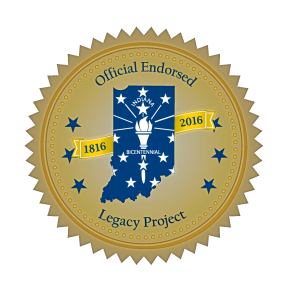IF THE RIVER COULD TALK
RIVERSIDE PROPERTY BECAME HOME
Various Indian Groups Flourished on the River

Throughout Indiana's Bicentennial year of 2016, Steve Jackson, Madison County Historian, will be authoring "If The River Could Talk." This series will feature people, places, and events that takes place in and around White River.
The series is an officially endorsed legacy project of the Indiana Bicentennial Commission.
The next record of Killbuck occurs in September, 1805, when he visited the Moravian mission station east of present-day Anderson. After that, there is no record of his whereabouts until after he returned with the Delaware when the tribe came back to the White River from Piqua, Ohio, at the conclusion of the War of 1812.
Some villages such as Anderson's Town were re-established while a few new ones were formed. One of the new ones was Killbuck's Town, or Buck's Town. The site was on a high bluff east of White River, one mile northwest of Chesterfield, Indiana on what later became the Carroll Bronnenberg farm. A government survey conducted in 1821 by Deputy Surveyor B. Bentley locates the village on that specific site.
If the river could talk, it may reveal the name of another Delaware Indian named Thomas White Eyes who was known to live at Killbuck's Town, but for how long is unknown. In a journal entry dated May 1806, the Moravian missionaries wrote unfavorably of him. It is speculated he was the son of Chief White Eyes who fought for the Americans during the War for Independence and died in November 1778. His widow, Mary, remarried and she and her new husband, Jacob Pemahoaland, accompanied the Moravian missionaries to Indiana in 1801 as converts.
Killbuck probably occupied this site until he was forced to leave the area in 1821 under the terms of the Treaty of St. Mary's, Ohio, which he signed in 1818. His mark on the treaty appears as Captain Killbuck. In Delaware tradition, the title of captain was given to the chiefs who assumed control of the tribe during times of conflict; they were generally considered next in rank under the head chief.
Today's traveler can easily find the site, which is a short distance southwest of the intersection of County Roads 75 North and 300 East. The former village site is occupied by a home located on the bluff that overlooks White River where it makes a sharp bend to the west.
Moravian Mission Continues as Village
If the river could talk, it would tell of an Indian village on the site of the former Moravian mission. A small congregation of Delaware converts to Christianity lived there in huts until the missionaries departed in September 1806. With the site firmer established after five years of Moravian occupation, it is likely the site continued to be a village for some time.
The last two villages belonged to a small band of Nanticoke Indians, who undoubtedly traveled with the Delaware to the White River in the 1790s. They first established a village on the river's left bank approximately eight miles west of Anderson's Town at the intersection of Madison County Road 800 West and 8th Street Road. The earliest known record of their presence at this location is June 1805. James Nanticoke was the chief of the small band and the village took its name from his wife, Nancy.
In December 1818, a village with the unusual name of Our Town was reported by Baptist Minister Isaac McCoy, who frequented the area, as being four miles west of Anderson's Town. His writings make reference to Nancy. She was considered an Indian woman of note who could speak English well, and who was the "principal manager of matter around her."
Stephen T. Jackson, Madison County Historian
Madison County Historical Society|15 West 11th Street, P. O. Box 696, Anderson, Indiana 46015-0696|(765)683-0052|madisonchs10@gmail.com